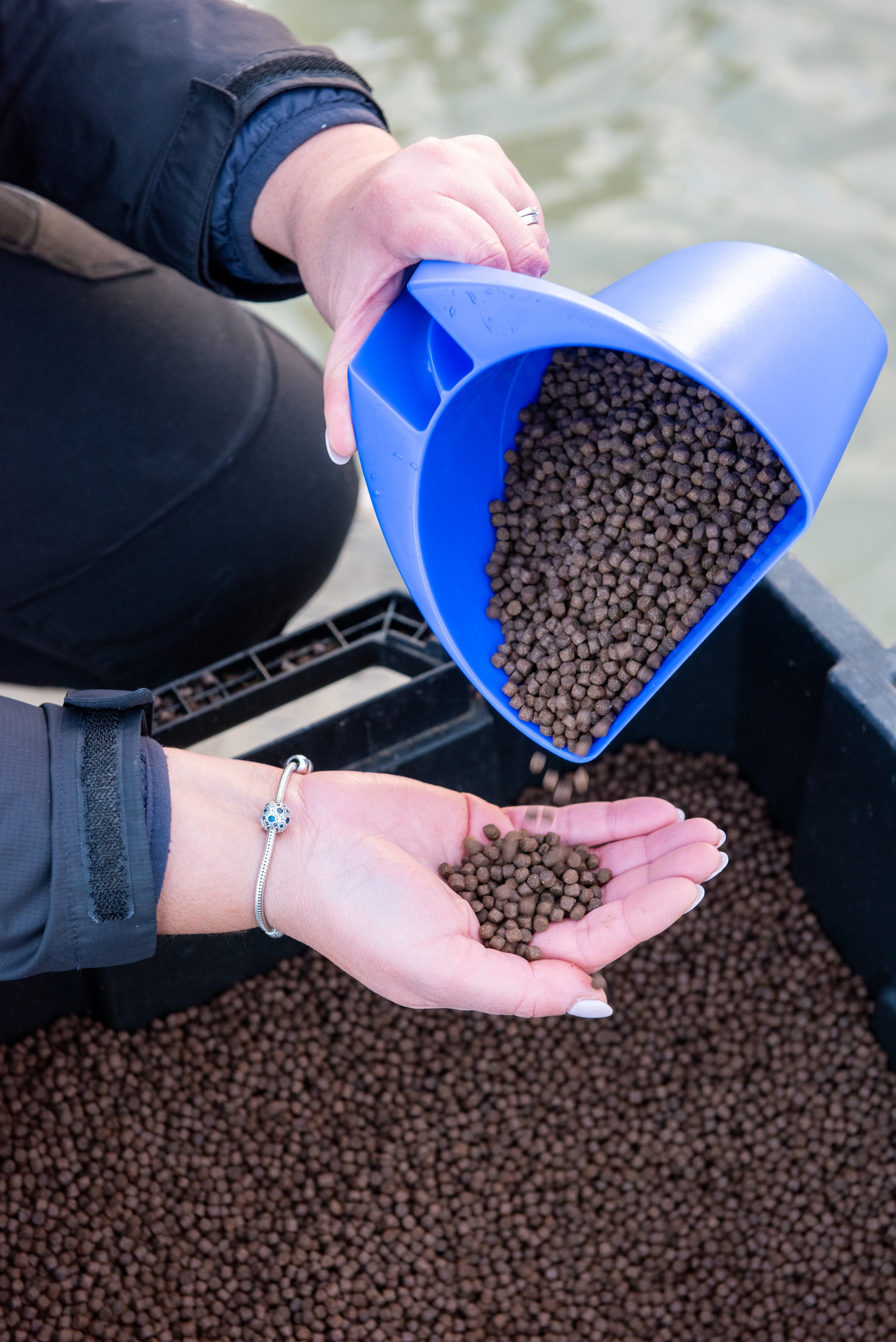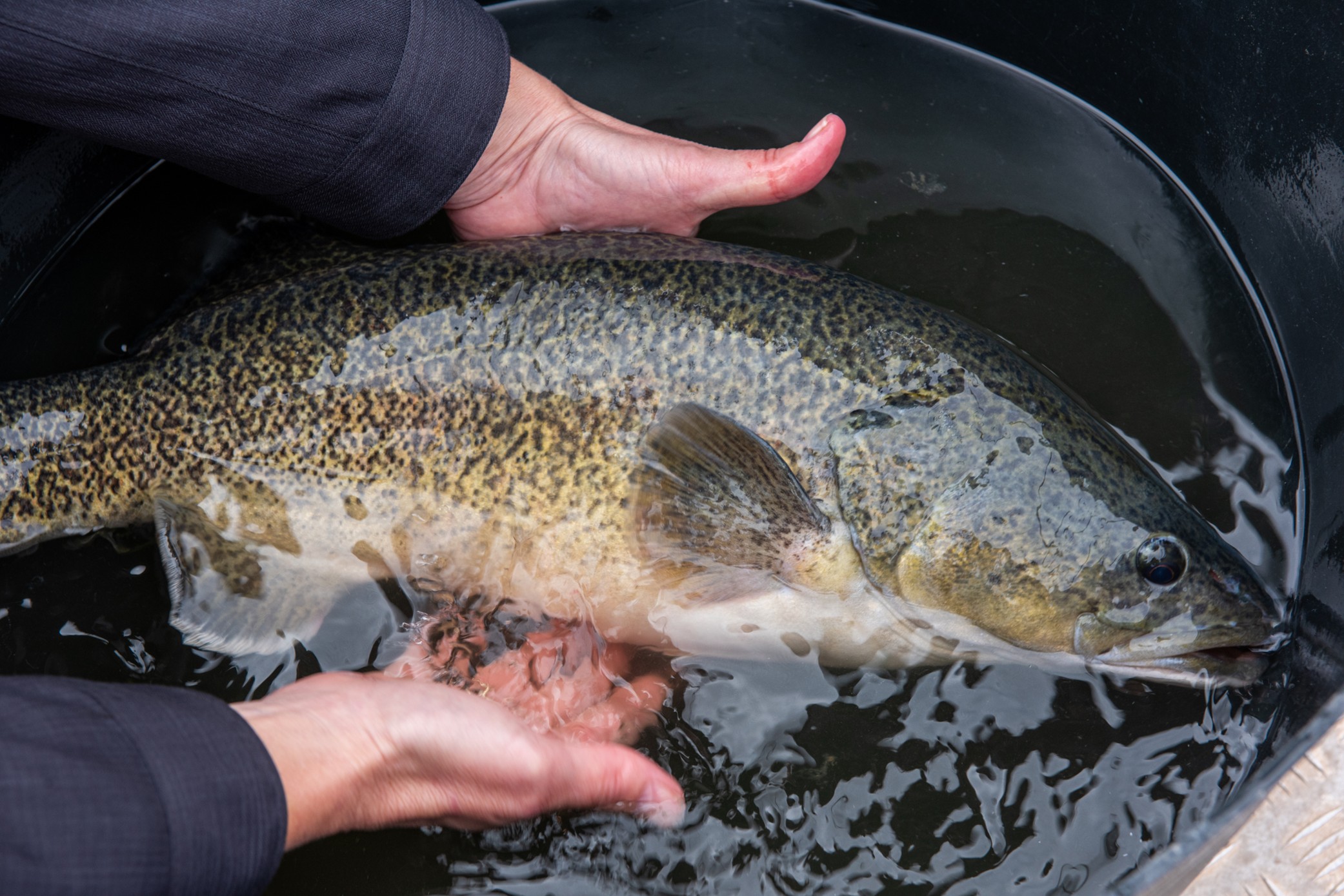New research is helping Murray Cod (Maccullochella peelii) farmers get more from every mouthful.
Australia’s aquaculture sector continues to scale up and Murray Cod (Maccullochella peelii) is earning its stripes as a source of national pride with exciting commercial potential. Producers are moving towards higher efficiency and sustainability, and asking themselves: what exactly should we be feeding these iconic natives as they grow?

A new FRDC-funded study (FRDC Project 2022-049) tackled that question head-on. Murray Cod Australia (MCA), the nation’s largest producer of premium Murray Cod, has collaborated with Deakin University to uncover nutritional insights into the optimal protein-to-energy balance and fishmeal inclusion for Murray Cod during key grow-out stages. The findings have provided insight into how feeding strategies can be fine-tuned to boost performance and reduce costs.
Food – or feed – for thought
Until now, most nutritional research on Murray Cod has focused on juveniles, leaving a gap in understanding how to feed fish as they approach harvest weights of 1.5–2.5 kilograms. This presents a financial and operational challenge as feed accounts for the largest cost in aquaculture and inadequate feeds can hamper growth, health and product quality.
While Atlantic Salmon (Salmo salar) and barramundi (Lates calcarifer) are well-established, Murray Cod is a uniquely Australian fish with exceptional eating quality and rising demand.

Prior to this study, Murray Cod were typically fed diets formulated for other species. While these feeds support growth, they don’t necessarily optimise performance or value. If the diet contains more protein than what Murray Cod need, the excess is excreted – wasting a costly nutrient and contributing to water quality issues. Without species-specific formulations, producers risk underutilising feed investments and compromising environmental outcomes.
“The Murray Cod is very close to my heart, and this project was about championing Australia’s emerging aquaculture species,” said Deakin University Professor David Francis, who is spearheading the project.
“The prominence of Muray Cod is growing rapidly, but when it comes to understanding the nutritional needs across the full production cycle, we’re still catching up.
“Compared to other species, the dietary knowledge base for Murray Cod remains relatively underdeveloped. This research aims to fill that gap and give farmers the tools they need to grow the species efficiently and sustainably.”
This study was designed to help the aquaculture sector better understand how to optimise diets as fish move through their grow-out stages. The research team ran two sequential feeding trials, testing a range of experimental diets on Murray Cod at different growth phases.
The first six months focused on the diets of Murray Cod weighing up to approximately 1.2 kilograms. The goal was to evaluate how varying levels of dietary protein, energy, mostly from lipids, and fishmeal affect key performance metrics like growth rate, feed efficiency, body composition and nutritional quality of the fillet.
The research team then repeated this approach over the next six months, focusing on larger fish approaching market size of approximately 2.5 kilograms.
What did they find?
The research shows that completely removing fishmeal isn’t ideal, especially for fish over 300 grams. An inclusion of 15 per cent of fishmeal strikes the right balance between performance and product quality. Likewise, tailoring the protein-to-energy ratio for different growth stages could help producers make smarter feeding decisions that maximise outputs without overfeeding expensive nutrients.
One of the most practical outcomes from the study is a clear set of dietary benchmarks for aquaculture farmers:
- Protein-to-energy ratio matters, especially for younger fish. Diets with higher protein-to-energy ratios deliver better feed conversion and protein utilisation in smaller cod. In contrast, larger fish are more likely to deposit excess lipids, especially when diets were energy-rich and lower in protein.
- Fishmeal still plays a role, particularly in bigger fish. Diets that include 15 per cent of fishmeal outperform those based entirely on plant proteins. This is especially true for fish over 300 grams, where fishmeal contributes to better feed efficiency and growth.
- Omega-3s don’t drive growth, but they improve fillet quality. While higher levels of omega-3 fatty acids don’t significantly change growth rates, they improve the nutritional quality of the final product. Fish fed omega-3-rich diets have better fillet fatty acid profiles, with higher concentrations of these heart-healthy fats.
“Many farmers are moving to diets containing alternative ingredients for sustainability and cost reasons, so it’s critical to know where the tipping points are,” David said.
Building a smarter feed future
This project provides a roadmap for further innovation as farmers now have some methods to refine their strategies, reduce waste and grow healthier fish, without compromising on quality.
David would like to see the development of bespoke diets tailored specifically to Murray Cod, with greater precision around the species’ unique nutritional requirements.
“There is still much to explore, particularly around the selection of raw materials and alternative ingredients to improve production efficiency and advance the sustainability profile of Murray Cod aquaculture as a whole,” David said.
As the sector moves towards more sustainable and efficient practices, the value of targeted, evidence-based nutrition can’t be overstated. Now is the time to set strong nutritional foundations.
“As the industry grows, having species-specific nutrition guidelines will empower producers to make informed decisions that support productivity,” said FRDC Project Manager Deepika Satchithananthan.
More information:
FRDC Project 2022-049 ‘Optimising the nutrition of farmed Murray Cod’





